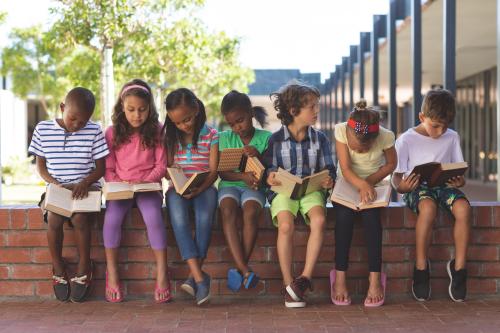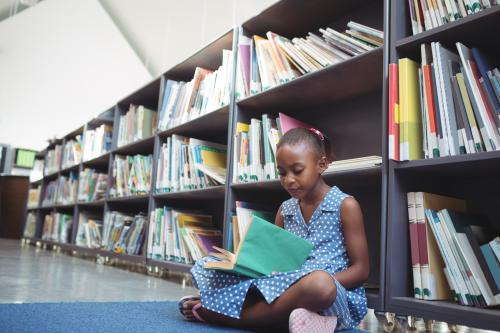Two out of every three students in the United States are not proficient readers. This was the headline that ricocheted across the United States in 2022 and 2023 following the release of the latest National Assessment of Educational Progress (NAEP) results. Just 33% of fourth graders met or exceeded proficiency on a test of their reading skills, while 37% of fourth graders performed below the basic level on the same assessment. Recognizing that NAEP proficiency is not equivalent to grade-level proficiency but a higher standard, most fourth graders still struggled with deeper critical thinking about texts.
For many, the news prompted legislation and policy changes endorsing literacy instruction aligned with the science of reading. For example, Colorado mandated that every student in the state’s public schools receive “evidence-based reading instruction” focused on phonics, vocabulary, and oral language skills. Washington, D.C. stated unequivocally, “Beginning with School Year 2024-2025, each [school district] shall adopt a science-based reading program.”
Impressively, these policies reflect the science of reading that has been fleshed out over the last few decades of research. Unimpressively, the public discourse surrounding the NAEP results created a new feud over whether phonics should be prioritized over meaning-making in the implementation of these policies. Two factors sparked the flames: First, the NAEP results fed discussions of learning loss. Second, journalist Emily Hanford produced a popular podcast, Sold a Story, in 2022, where she squarely blamed a particular and widely used instructional approach called the Three-Cueing technique as the culprit behind students’ struggles to read. In Three-Cueing, students attempt to read unfamiliar words by deriving their meaning from context. As Hanford rightly argued, phonics was downplayed in Three-Cueing even though it is key to the science of how children read.
The science of reading
Today, the science of reading is well understood based on research conducted over the past several decades. Neuroscientist Stanislas DeHaene argues that a brain region called the visual word form area (VWFA) was coopted to connect the visual area with the language area, the latter rich in meaning and knowledge. In reading—a cultural invention—the task is to link the two areas. Thus, both phonics and meaning-based instruction are needed when teaching reading. And much commentary has spelled out how a true “evidence-based” approach must encompass techniques that build skill in phonics along with language skills and world knowledge.
The effectiveness of teaching phonics was demonstrated in a series of experiments by Brian Byrne and colleagues. After preschool students were taught how the words for different objects all began or ended with the same sound, they not only correctly read letters and words with sounds on which they were trained, but they could also transfer their knowledge to read new letters and words. Additional research shows positive effects of phonics instruction on an array of reading outcomes, including text comprehension.
Highlighting phonics to the exclusion of meaning-making, however, has proven ineffective. Mark Seidenberg and colleagues acknowledge that reading interventions solely focused on helping students connect letters and sounds generated mixed results. Nell Duke and colleagues similarly convey the importance of early reading comprehension instruction alongside phonics, which enhances both skills. Susan Engel and Catherine Snow further encourage students’ “deep reading comprehension,” which includes making inferences about a text and connecting new information from a text with relevant background knowledge. As Engel and Snow assert, “Phonics are undoubtedly a building block of reading, but schools are preoccupied with this method. To truly fix learning loss, we must help kids gather information and teach them the tools for expanding their knowledge.”
An extensive review of the science by Anne Castles and colleagues puts the so-called reading wars from the 1980s behind us. The related skills necessary to become a reader are famously depicted in Scarborough’s “reading rope,” which illustrates how reading emerges from mastery of both language comprehension and word recognition or phonics-based decoding.
Avoiding the rabbit hole by following the science
National policies are reflecting the science as they advance curricula and training that should help all children read at grade level. The low NAEP scores and a compelling podcast, however, thrust the nation into an unfortunate, oversimplified debate of phonics vs. meaning—a debate that has consequences as policy morphs into classroom practice.
In a rare move to ensure that implementation matches policy, educators using the Equitable Literacy program in Boston Public Schools are bringing the science into the classroom. They offer a strong example of instruction that prioritizes phonics, while at the same time building the knowledge that students need to support reading.
If we include both phonics and meaning, then and only then, can we expect all children to meet grade-level and even NAEP expectations. It is imperative to change the status quo in reading achievement. We must do better in the U.S. and around the globe. As evidence-based policies move from legislatures to classrooms, however, we must not rekindle the polarized wars of the past. Let’s embrace the science fully, with all of its nuance, to ensure that Johnny (and Jenny) learn to read.
The Brookings Institution is committed to quality, independence, and impact.
We are supported by a diverse array of funders. In line with our values and policies, each Brookings publication represents the sole views of its author(s).








Commentary
Following the science to end the reading wars
A false dichotomy won’t help Johnny read
December 7, 2023